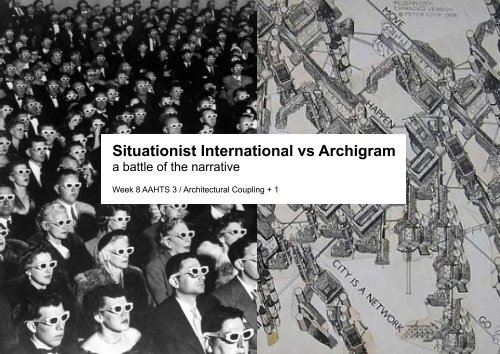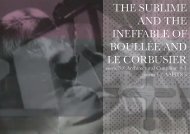Situationist and Archigram
Situationist and Archigram
Situationist and Archigram
Create successful ePaper yourself
Turn your PDF publications into a flip-book with our unique Google optimized e-Paper software.
<strong>Situationist</strong> International vs <strong>Archigram</strong><br />
a battle of the narrative<br />
Week 8 AAHTS 3 / Architectural Coupling + 1
[excerpt] Towards a New Architecture, 1923 by Le Corbusier
“Without plan there can be neither gr<strong>and</strong>eur of<br />
aim <strong>and</strong> expression, nor rhythm, nor mass, nor<br />
coherence. Without plan we have the sensation,<br />
so insupportable to man, of shapelessness, of<br />
poverty, of disorder, of wilfulness. A plan calls<br />
for the most active imagination. It calls for the<br />
most severe discipline also. The plan is what<br />
determines everything; it is the decisive<br />
moment.”<br />
[quote] Towards a New Architecture, 1923 by Le Corbusier<br />
[image] Plan Voisin, 1925 by Le Corbusier
[image] Plan Voisin detail, 1925 by Le Corbusier
[images] covers of L’Esprit Nouveau, 1919-24 by Le Corbusier
[image] Pavillion L’Esprit Nouveau, 1925 by Le Corbusier
[image] members of CIAM at CIAM I in La Sarraz, Switzerl<strong>and</strong>, 1928
[image] members of CIAM at CIAM I “playing about”, 1928
[above] cover of Athens Charter, 1943 published by Le Corbusier
[above] Cafe Notre-Dame, where CoBrA was founded<br />
[right] founding members of CoBrA - Constant <strong>and</strong> Asger Jorn amongst others
“In this period of change, the role<br />
of the creative artist can only be that<br />
of the revolutionary: it is his duty<br />
to destroy the last remnants of<br />
an empty, irksome aesthetic,<br />
arousing the creative instincts still<br />
slumbering unconscious in the human<br />
mind.<br />
The masses, brought up with aesthetic<br />
conventions imposed from without,<br />
are as yet unaware of their creative<br />
potential.<br />
This will be stimulated by an art which<br />
does not define but suggests, by the<br />
arousal of associations <strong>and</strong> the<br />
speculations which come forth<br />
from them, creating a new <strong>and</strong><br />
fantastic way of seeing.”<br />
[above] Manifesto of the Dutch Experimental Group<br />
by Constant published 1948 in Reflex #1
[right] To Us, Liberty by Constant, 1949<br />
[top] cover of Reflex<br />
[bottom] scan of CoBRa Journal cover
“...buildings must not be squalid or<br />
anonymous, neither should they be show<br />
pieces from a museum; rather they must<br />
commune with each other, integrate with<br />
the environment to create synthesised<br />
‘cities’ for a new socialist world.”<br />
[above] Except from Towards a Symbolic Architecture by Michel<br />
Colle published 1948 in CoBrA journal #1<br />
[image] drawings from Corbusier’s Radiant City
The Man of the Crowd, 1840 by Edgar Allen Poe<br />
[above left] image from 1923 London edition by Harry Clarke<br />
[above right] a 1943 etching by Fritz Eichenberg
[above] Hackney, That Rose-red Empire: A Confidential Report, 2009 by Iain Sinclair
Looking for ... a symbiosis<br />
potentialities<br />
freedom<br />
Evoking ... w<strong>and</strong>ering<br />
authenticity<br />
a new way of seeing<br />
desires<br />
By way of ... the individual<br />
(in the city)<br />
[image] map of Paris, 1952 by Guy Debord
Letterist International - faction of Letterist Group<br />
Letterist Group - formed by Isidore Isou in Paris in the 1940s<br />
Letterist Internationl - formed by Guy Debord in Paris in 1952<br />
[image] a photograph taken by Isidore Isou of himself in Paris
“On the bases of this mobile civilization,<br />
architecture will, at least initially, be a means<br />
of experimenting with a thous<strong>and</strong> ways of<br />
modifying life, with a view to an ultimate [...]<br />
synthesis.”<br />
[above] quote from Formulary for a New Urbanism, 1953, Ivan Chtcheglov<br />
[left] Prison or Death for the Young, 1950 by Ivan Chtcheglov<br />
[below] Ivan Chtcheglov
Psychogeography is<br />
“... the study of precise laws <strong>and</strong><br />
specific effects of the geographical<br />
environment, consciously<br />
organised or not, on the emotions<br />
<strong>and</strong> behaviours of individuals”<br />
[above] definition of psychogeography, 1955 by Guy<br />
Debord, developed from Ivan Ctcheglov’s wrting<br />
[left] plotting of a student’s trajectories over one year in<br />
Paris by Paul-Henri Chombart de Lauwe
[left] Letterist<br />
Group<br />
[left] Letterist<br />
International<br />
[right] CoBrA<br />
[right] International<br />
Movement for an<br />
Imaginist Bauhaus<br />
[below] <strong>Situationist</strong> International (SI) [1957]
[image] graph of the texts of the SItuationist International<br />
slide with all of the texts of SI
Theory of the Dérive by Guy Debord<br />
questioned how to remove ourselves from the<br />
rigidity of our daily lives, paths, behaviours <strong>and</strong><br />
seeked how to enable the narratives of our<br />
daily lives to become flexible, authentic, with a<br />
sense of awareness<br />
[above] published in 1958 in International Situationniste #2<br />
[image] a scene from Guy Debord’s 1961 film Society of the Spectacle
dérive (verb)<br />
to float, drift, drifting (from the French)<br />
it is similiar to the Letterist term détourement<br />
(a subversive act) <strong>and</strong> is key in the<br />
construction of situations, or moments of<br />
rupture with everyday life<br />
“a technique of rapid passage through<br />
various ambiances [...] involves playfulconstructive<br />
behaviour <strong>and</strong> an awareness of<br />
psychogeographical effects...”<br />
[quote] “Theory of the Derive” by Guy Debord published in 1958 in<br />
International Situationniste #2<br />
[image] Guy Debord long exposure, smoking
[image] Psychogeographic Map of Paris, 1955 by Guy Debord
It could be continuous like the poker game in Las<br />
Vegas, but only for a certain period, limited to a<br />
weekend for some people, to a week as a good average;<br />
a month is really pushing it. In 1953-1954 we dérived<br />
for three or four months straight. That’s the extreme<br />
limit. It’s a miracle it didn’t kill us.<br />
[excerpt] from a letter from Ivan Chtcheglov to Guy Debord in 1963, reprinted in<br />
Internationale Situationniste #9
[image] The Naked City, 1958 by Guy Debord & Asger Jorn
Guy Debord & Asger<br />
Jorn interpreted as<br />
meaning architecture<br />
that exists, ie the city<br />
“On the bases of this mobile civilization,<br />
architecture will, at least initially, be a means of<br />
experimenting with a thous<strong>and</strong> ways of modifying<br />
life, with a view to an ultimate [...] synthesis.”<br />
[excerpt] Formulary for a New Urbanism, 1950 by Ivan Chtcheglov<br />
Constant interpreted<br />
as meaning<br />
architecture that can<br />
be constructed
Unitary urbanism – a synthesis of art<br />
<strong>and</strong> technology must be constructed<br />
[above] called for Gil J. Wolman, 1957<br />
[image] collage by Gil J. Wolman, 1950s
Guy Debord<br />
focused on content<br />
via the dérive<br />
vs<br />
Constant<br />
had a structural<br />
approach
[image] Life Continues to be Free <strong>and</strong><br />
Easy by Guy Debord, 1959 - gift to<br />
Constant
[image] Amsterdam Municipal Orphanage, 1955-1960 by Aldo van Eyck
[image] cover of Potlatch #3 with drawing of Alison<br />
<strong>and</strong> Peter Smithson’s Golden Lane Project, 1953 as it<br />
appeared for CIAM 9
[images] New Bablyon over parts of Engl<strong>and</strong> by Constant
[image] Space Travel, 1957 by Constant
[images] Nebulous Machine wire constructions, 1958 by Constant
[image] New Babylon collaged over existing city by Constant
[image] New Babylon collaged over a region by Constant
[image] New Babylon - autonomous from ground by Constant
[images] New Babylon as a new map by Constant
[images] models of New Babylon by Constant
[image] New Babylon collage - view from the ground by Constant
[images] inside New Babylon being transformed by Constant
[images] <strong>Archigram</strong> in the 1960s - Peter Cook, David Greene, Mike Webb, Ron Herron,<br />
Warren Chalk, <strong>and</strong> Dennis Crompton - <strong>and</strong> again in the 1990s in the AA Library
[images] pages of <strong>Archigram</strong> 1 from 1961 - broadsheet published by <strong>Archigram</strong>
[image] <strong>Archigram</strong> 2 cover
[top] pages of Dream City project, 1963 by David Greene <strong>and</strong> Michael Webb<br />
[left] compared to New Babylon by Constant, the suspended city
[left] cover of <strong>Archigram</strong> 3 - Expendable Architecture<br />
[right] cover of <strong>Archigram</strong> 4 - Amazing <strong>Archigram</strong> Zoom
[above] Plug-in City 1962-64 developed by Peter Cook <strong>and</strong> Dennis Crompton
[above] Plug-in City 1962-64 developed by Peter Cook <strong>and</strong> Dennis Crompton - office <strong>and</strong> housing units for Charing Cross Road<br />
“The term “city” is used as a collective, the project<br />
being a portmanteau for several ideas, <strong>and</strong> does not<br />
necessarily imply a replacement of known cities.”<br />
[excerpt] from Peter Cook’s writing on Plug-in City, from Westminster’s<br />
<strong>Archigram</strong> Archival Project Online
Thank you. (Peter Cook at Thrilling Wonder Series in 2009 - 5 t-shirts in 30 min)



